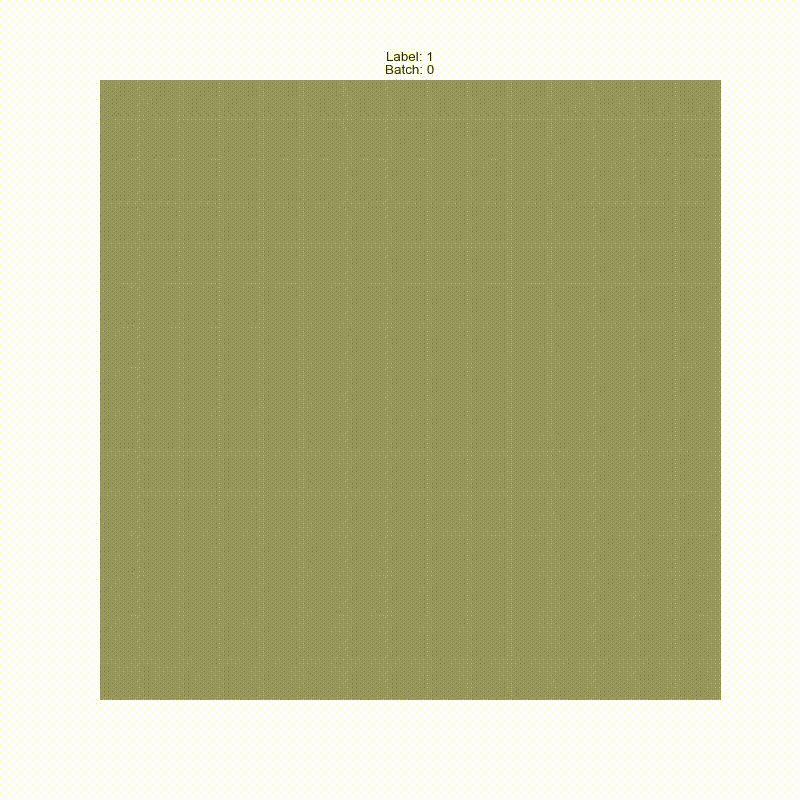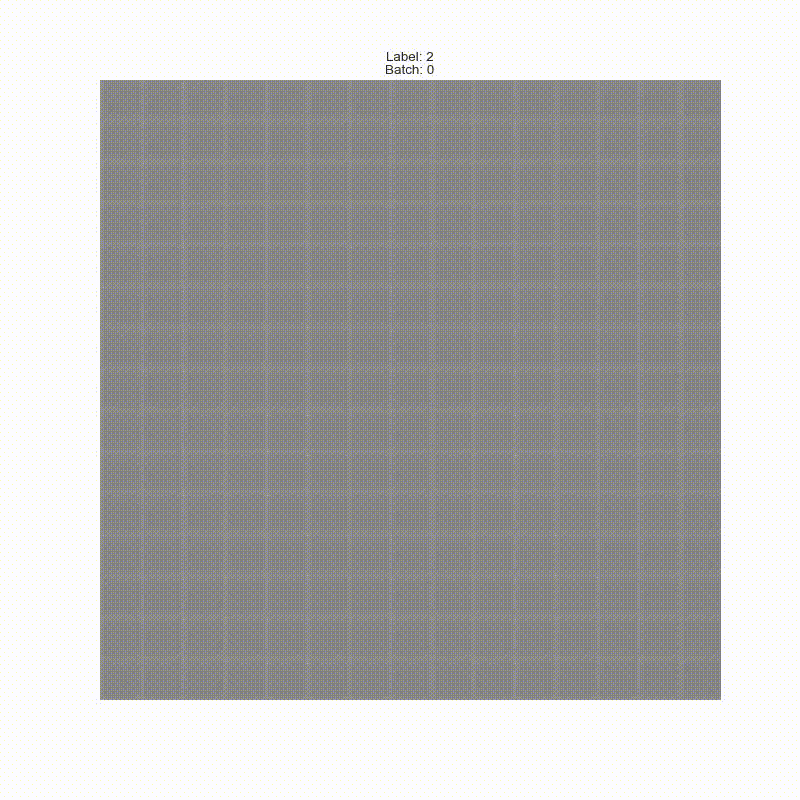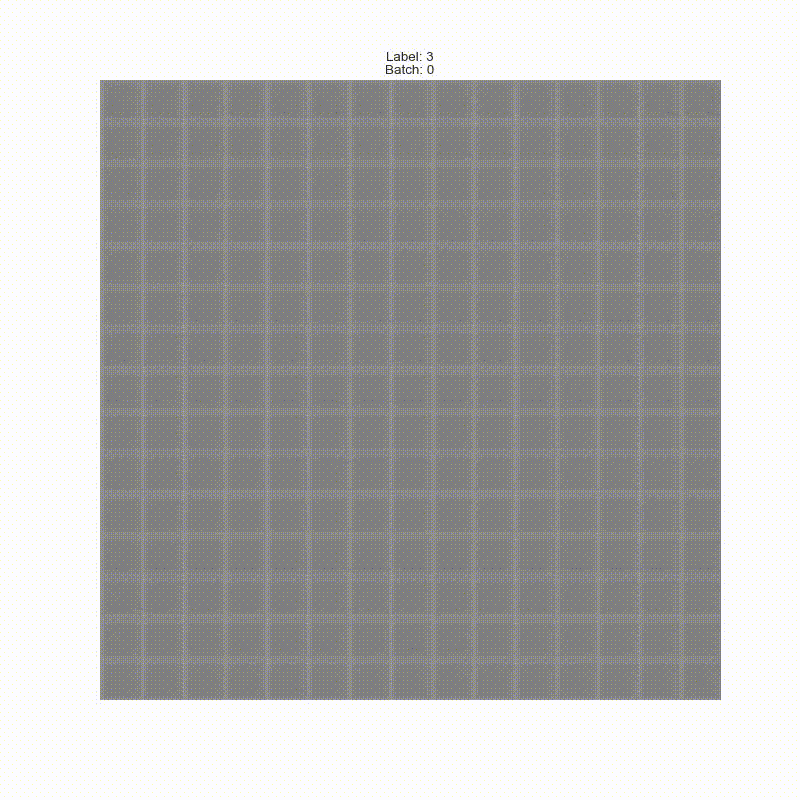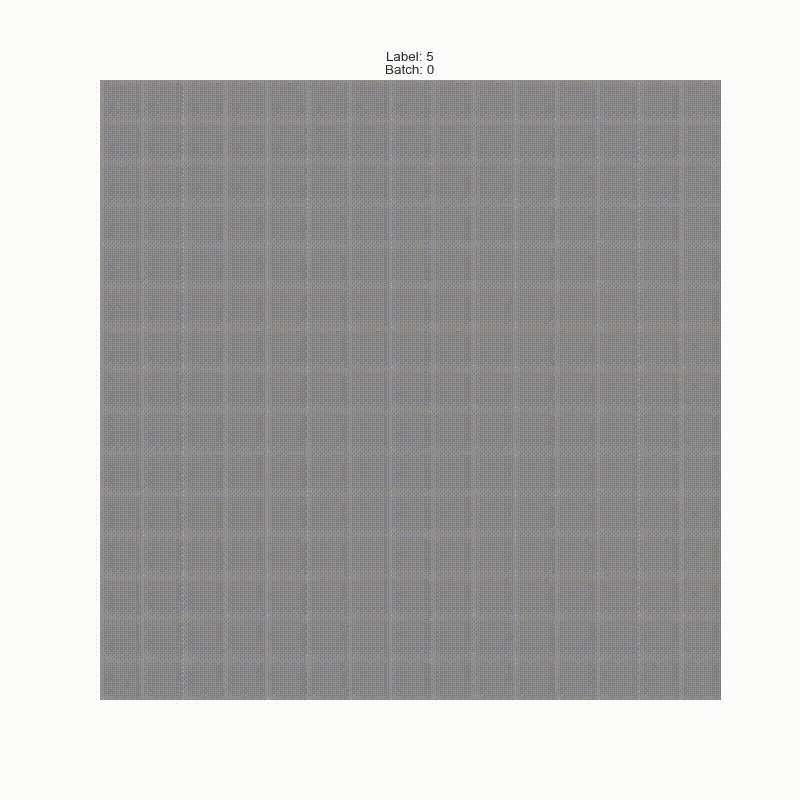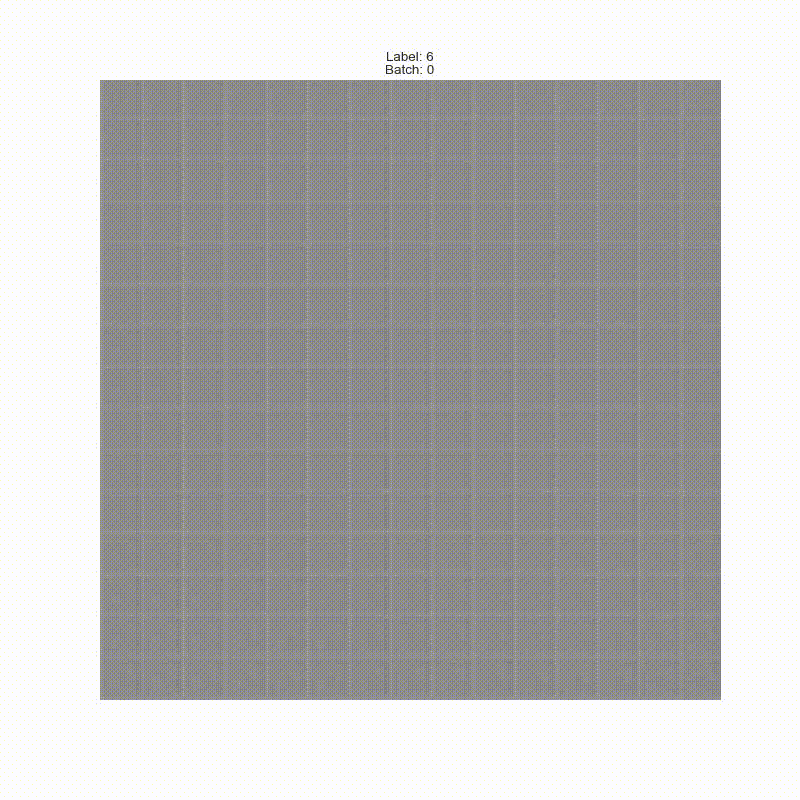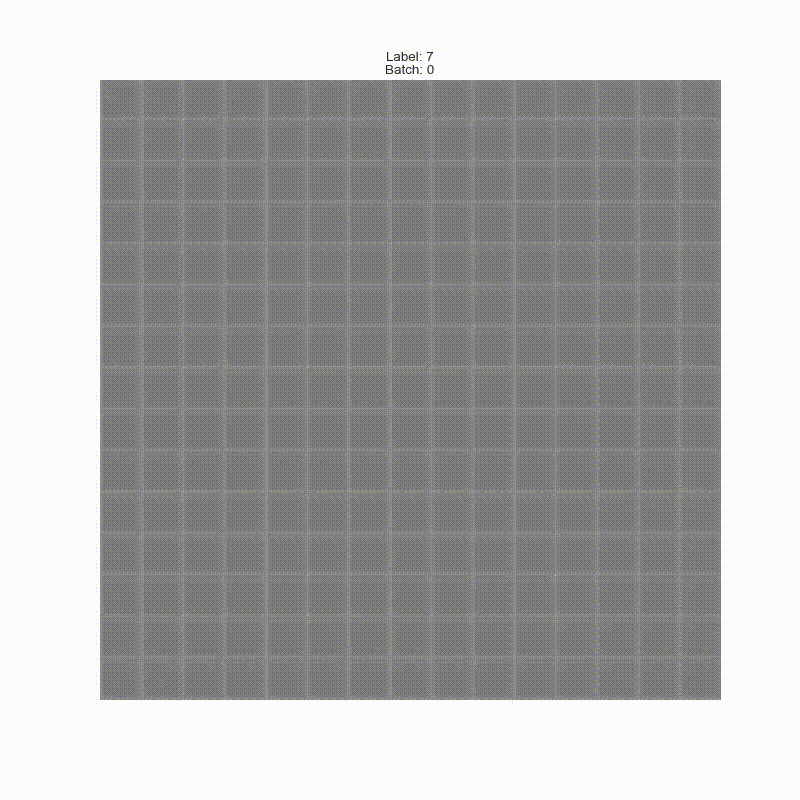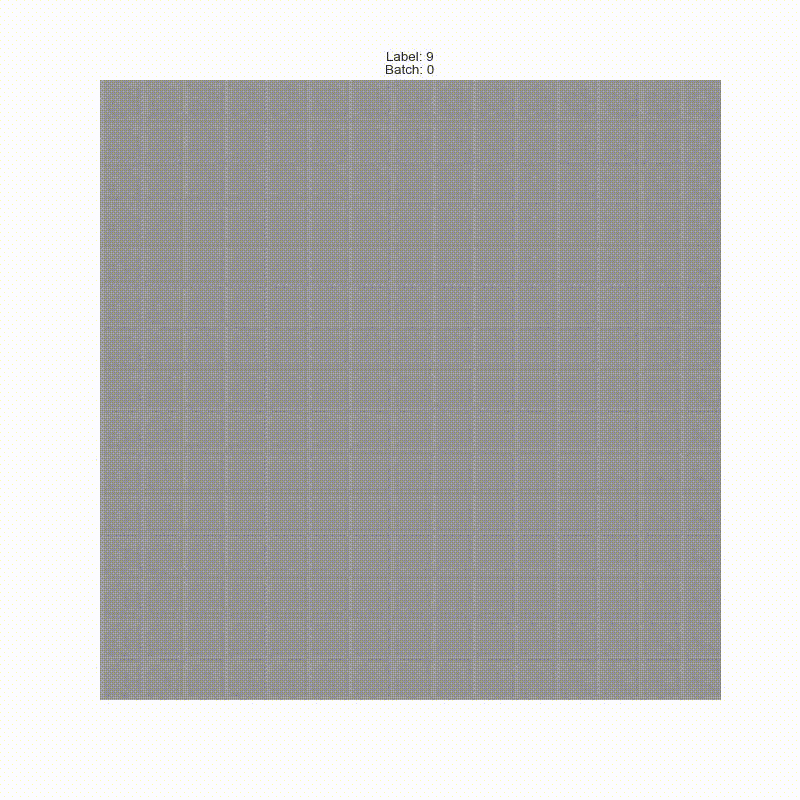Autoencoders in Keras, Part 6: VAE + GAN
Content
- Part 1: Introduction
- Part 2: Manifold learning and latent variables
- Part 3: Variational autoencoders ( VAE )
- Part 4: Conditional VAE
- Part 5: GAN (Generative Adversarial Networks) and tensorflow
- Part 6: VAE + GAN
In the previous part, we created a CVAE autoencoder, whose decoder is able to generate a digit of a given label, we also tried to create pictures of numbers of other labels in the style of a given picture. It turned out pretty good, but the numbers were generated blurry.
In the last part, we studied how the GANs work, getting quite clear images of numbers, but the possibility of coding and transferring the style was lost.
In this part we will try to take the best from both approaches by combining variational autoencoders ( VAE ) and generative competing networks ( GAN ).
')
The approach, which will be described later, is based on the article [Autoencoding beyond pixels using a learned similarity metric, Larsen et al, 2016] .

Illustration of [1]
We will understand in more detail why the recovered images are blurry.
In the part about VAE , the process of image generation was considered.
Since the dimension of hidden variables
Where
When we train autoencoders, we compare the input from the sample
Where
Asking
Minimizing
If the noise
Returning to the pictures: let's see how the pixel metric is connected, which defines the loss in the previous parts, and the metric used by the person. An example and illustration from [2] :
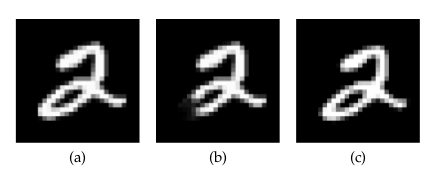
In the picture above:
(a) - the original image of the digit,
(b) - obtained from (a) by cutting a piece,
(c) is the digit (a) shifted half a pixel to the right.
In terms of per-pixel metric, (a) is much closer to (b) than to (c); although from the point of view of human perception (b) is not even a figure, but the difference between (a) and (b) is almost imperceptible.
Autoencoders with a pixel-by-pixel metric thus blurred the image, reflecting the fact that within the limits of close
- the position of the figures slightly walks in the picture,
- figures are drawn slightly differently (although pixel-by-pixel can be far away).
According to the metrics of human perception, the fact that the figure has blurred already makes it be very different from the original. Thus, if we know the person’s metric or close to it and optimize in it, the numbers will not be eroded, and the importance of the figure being full, not like from the picture (b), will increase dramatically.
You can try to manually invent a metric that will be closer to the human. But using the GAN approach, it is possible to train the neural network to look for a good metric itself.
About GAN'y written in the last part.
Connecting VAE and GAN
The GAN generator performs a function similar to the decoder in VAE : both samples are from a prior distribution
The idea is to add a third network to the VAE - the discriminator and feed the input and the restored object and the original to it, and train the discriminator to determine which one is which.

Illustration of [1]
Of course, we can no longer use the same comparison metric from VAE , because, while studying in it, the decoder generates images that are easily distinguishable from the original. Do not use the metric at all - either, since we would like the recreated
Let us think, however, about this: the discriminator, learning to distinguish between a real object and a generated one, will isolate some characteristic features of one and the other. These features of the object will be encoded in the layers of the discriminator, and based on their combination, it will already give the probability of the object to be real. For example, if the image is blurred, then some kind of neuron in the discriminator will activate more strongly than if it is clear. Moreover, the deeper the layer, the more abstract characteristics of the input object are encoded in it.
Since each discriminator layer is a code-description of an object and at the same time encodes features that allow the discriminator to distinguish generated objects from real ones, it is possible to replace some simple metric (for example, pixel-by-pixel) with a metric over neuronal activations in one of the layers:
Where
At the same time, it is hoped that the new metric
Below is a diagram of the work of the resulting VAE + GAN network, proposed by the authors [1] .
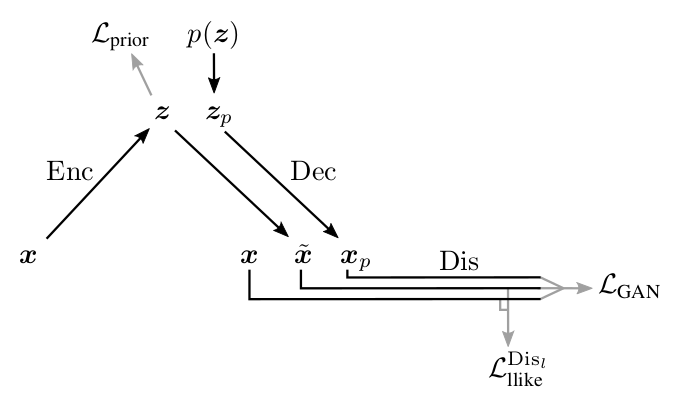
Illustration of [1]
Here:
- input object from
,
- sampled
of
,
- object generated by decoder from
,
- object recovered from
,
- loss forcing the encoder to translate
in the right for us
(just like in part 3 about VAE ),
- metric between activations
layer of discriminator
on real
and restored
,
- cross-entropy between the real distribution of labels of real / generated objects, and the probability distribution predicted by the discriminator.
As with the GAN , we cannot train all 3 parts of the network at the same time. The discriminator should be trained separately, in particular, it is not necessary that the discriminator try to reduce
The scheme proposed by the authors:
Above it can be seen on which Loss what networks study. Particular attention should be paid to the decoder: on the one hand, it tries to reduce the distance between the input and the output in the metric of the lth discriminator layer (
Code
The code largely repeats what was in the previous parts about pure VAE and GAN .
Again, we will immediately write the conditional model.
from IPython.display import clear_output import numpy as np import matplotlib.pyplot as plt %matplotlib inline import seaborn as sns from keras.layers import Dropout, BatchNormalization, Reshape, Flatten, RepeatVector from keras.layers import Lambda, Dense, Input, Conv2D, MaxPool2D, UpSampling2D, concatenate from keras.layers.advanced_activations import LeakyReLU from keras.layers import Activation from keras.models import Model, load_model # keras from keras import backend as K import tensorflow as tf sess = tf.Session() K.set_session(sess) # from keras.datasets import mnist from keras.utils import to_categorical (x_train, y_train), (x_test, y_test) = mnist.load_data() x_train = x_train.astype('float32') / 255. x_test = x_test .astype('float32') / 255. x_train = np.reshape(x_train, (len(x_train), 28, 28, 1)) x_test = np.reshape(x_test, (len(x_test), 28, 28, 1)) y_train_cat = to_categorical(y_train).astype(np.float32) y_test_cat = to_categorical(y_test).astype(np.float32) # batch_size = 64 batch_shape = (batch_size, 28, 28, 1) latent_dim = 8 num_classes = 10 dropout_rate = 0.3 gamma = 1 # # def gen_batch(x, y): n_batches = x.shape[0] // batch_size while(True): idxs = np.random.permutation(y.shape[0]) x = x[idxs] y = y[idxs] for i in range(n_batches): yield x[batch_size*i: batch_size*(i+1)], y[batch_size*i: batch_size*(i+1)] train_batches_it = gen_batch(x_train, y_train_cat) test_batches_it = gen_batch(x_test, y_test_cat) # x_ = tf.placeholder(tf.float32, shape=(None, 28, 28, 1), name='image') y_ = tf.placeholder(tf.float32, shape=(None, 10), name='labels') z_ = tf.placeholder(tf.float32, shape=(None, latent_dim), name='z') img = Input(tensor=x_) lbl = Input(tensor=y_) z = Input(tensor=z_) The description of models from GAN differs almost only in the added encoder.
def add_units_to_conv2d(conv2, units): dim1 = int(conv2.shape[1]) dim2 = int(conv2.shape[2]) dimc = int(units.shape[1]) repeat_n = dim1*dim2 units_repeat = RepeatVector(repeat_n)(lbl) units_repeat = Reshape((dim1, dim2, dimc))(units_repeat) return concatenate([conv2, units_repeat]) # , - (, - , P P_g ) def apply_bn_relu_and_dropout(x, bn=False, relu=True, dropout=True): if bn: x = BatchNormalization(momentum=0.99, scale=False)(x) if relu: x = LeakyReLU()(x) if dropout: x = Dropout(dropout_rate)(x) return x with tf.variable_scope('encoder'): x = Conv2D(32, kernel_size=(3, 3), strides=(2, 2), padding='same')(img) x = apply_bn_relu_and_dropout(x) x = MaxPool2D((2, 2), padding='same')(x) x = Conv2D(64, kernel_size=(3, 3), padding='same')(x) x = apply_bn_relu_and_dropout(x) x = Flatten()(x) x = concatenate([x, lbl]) h = Dense(64)(x) h = apply_bn_relu_and_dropout(h) z_mean = Dense(latent_dim)(h) z_log_var = Dense(latent_dim)(h) def sampling(args): z_mean, z_log_var = args epsilon = K.random_normal(shape=(batch_size, latent_dim), mean=0., stddev=1.0) return z_mean + K.exp(K.clip(z_log_var/2, -2, 2)) * epsilon l = Lambda(sampling, output_shape=(latent_dim,))([z_mean, z_log_var]) encoder = Model([img, lbl], [z_mean, z_log_var, l], name='Encoder') with tf.variable_scope('decoder'): x = concatenate([z, lbl]) x = Dense(7*7*128)(x) x = apply_bn_relu_and_dropout(x) x = Reshape((7, 7, 128))(x) x = UpSampling2D(size=(2, 2))(x) x = Conv2D(64, kernel_size=(5, 5), padding='same')(x) x = apply_bn_relu_and_dropout(x) x = Conv2D(32, kernel_size=(3, 3), padding='same')(x) x = UpSampling2D(size=(2, 2))(x) x = apply_bn_relu_and_dropout(x) decoded = Conv2D(1, kernel_size=(5, 5), activation='sigmoid', padding='same')(x) decoder = Model([z, lbl], decoded, name='Decoder') with tf.variable_scope('discrim'): x = Conv2D(128, kernel_size=(7, 7), strides=(2, 2), padding='same')(img) x = MaxPool2D((2, 2), padding='same')(x) x = apply_bn_relu_and_dropout(x) x = add_units_to_conv2d(x, lbl) x = Conv2D(64, kernel_size=(3, 3), padding='same')(x) x = MaxPool2D((2, 2), padding='same')(x) x = apply_bn_relu_and_dropout(x) # l- l = Conv2D(16, kernel_size=(3, 3), padding='same')(x) x = apply_bn_relu_and_dropout(x) h = Flatten()(x) d = Dense(1, activation='sigmoid')(h) discrim = Model([img, lbl], [d, l], name='Discriminator') Building a graph of calculations based on models:
z_mean, z_log_var, encoded_img = encoder([img, lbl]) decoded_img = decoder([encoded_img, lbl]) decoded_z = decoder([z, lbl]) discr_img, discr_l_img = discrim([img, lbl]) discr_dec_img, discr_l_dec_img = discrim([decoded_img, lbl]) discr_dec_z, discr_l_dec_z = discrim([decoded_z, lbl]) cvae_model = Model([img, lbl], decoder([encoded_img, lbl]), name='cvae') cvae = cvae_model([img, lbl]) Loss Definition:
Interestingly, the result was slightly better if the cross-entropy rather than MSE was taken as the metric for layer activations.
# L_prior = -0.5*tf.reduce_sum(1. + tf.clip_by_value(z_log_var, -2, 2) - tf.square(z_mean) - tf.exp(tf.clip_by_value(z_log_var, -2, 2)))/28/28 log_dis_img = tf.log(discr_img + 1e-10) log_dis_dec_z = tf.log(1. - discr_dec_z + 1e-10) log_dis_dec_img = tf.log(1. - discr_dec_img + 1e-10) L_GAN = -1/4*tf.reduce_sum(log_dis_img + 2*log_dis_dec_z + log_dis_dec_img)/28/28 # L_dis_llike = tf.reduce_sum(tf.square(discr_l_img - discr_l_dec_img))/28/28 L_dis_llike = tf.reduce_sum(tf.nn.sigmoid_cross_entropy_with_logits(labels=tf.sigmoid(discr_l_img), logits=discr_l_dec_img))/28/28 # , , L_enc = L_dis_llike + L_prior L_dec = gamma * L_dis_llike - L_GAN L_dis = L_GAN # optimizer_enc = tf.train.RMSPropOptimizer(0.001) optimizer_dec = tf.train.RMSPropOptimizer(0.0003) optimizer_dis = tf.train.RMSPropOptimizer(0.001) encoder_vars = tf.get_collection(tf.GraphKeys.TRAINABLE_VARIABLES, "encoder") decoder_vars = tf.get_collection(tf.GraphKeys.TRAINABLE_VARIABLES, "decoder") discrim_vars = tf.get_collection(tf.GraphKeys.TRAINABLE_VARIABLES, "discrim") step_enc = optimizer_enc.minimize(L_enc, var_list=encoder_vars) step_dec = optimizer_dec.minimize(L_dec, var_list=decoder_vars) step_dis = optimizer_dis.minimize(L_dis, var_list=discrim_vars) def step(image, label, zp): l_prior, dec_image, l_dis_llike, l_gan, _, _ = sess.run([L_prior, decoded_z, L_dis_llike, L_GAN, step_enc, step_dec], feed_dict={z:zp, img:image, lbl:label, K.learning_phase():1}) return l_prior, dec_image, l_dis_llike, l_gan def step_d(image, label, zp): l_gan, _ = sess.run([L_GAN, step_dis], feed_dict={z:zp, img:image, lbl:label, K.learning_phase():1}) return l_gan Functions of drawing pictures after and during the training:
Code
digit_size = 28 def plot_digits(*args, invert_colors=False): args = [x.squeeze() for x in args] n = min([x.shape[0] for x in args]) figure = np.zeros((digit_size * len(args), digit_size * n)) for i in range(n): for j in range(len(args)): figure[j * digit_size: (j + 1) * digit_size, i * digit_size: (i + 1) * digit_size] = args[j][i].squeeze() if invert_colors: figure = 1-figure plt.figure(figsize=(2*n, 2*len(args))) plt.imshow(figure, cmap='Greys_r') plt.grid(False) ax = plt.gca() ax.get_xaxis().set_visible(False) ax.get_yaxis().set_visible(False) plt.show() # , , figs = [[] for x in range(num_classes)] periods = [] save_periods = list(range(100)) + list(range(100, 1000, 10)) n = 15 # 15x15 from scipy.stats import norm # N(0, I), , grid_x = norm.ppf(np.linspace(0.05, 0.95, n)) grid_y = norm.ppf(np.linspace(0.05, 0.95, n)) grid_y = norm.ppf(np.linspace(0.05, 0.95, n)) def draw_manifold(label, show=True): # figure = np.zeros((digit_size * n, digit_size * n)) input_lbl = np.zeros((1, 10)) input_lbl[0, label] = 1 for i, yi in enumerate(grid_x): for j, xi in enumerate(grid_y): z_sample = np.zeros((1, latent_dim)) z_sample[:, :2] = np.array([[xi, yi]]) x_decoded = sess.run(decoded_z, feed_dict={z:z_sample, lbl:input_lbl, K.learning_phase():0}) digit = x_decoded[0].squeeze() figure[i * digit_size: (i + 1) * digit_size, j * digit_size: (j + 1) * digit_size] = digit if show: # plt.figure(figsize=(15, 15)) plt.imshow(figure, cmap='Greys') plt.grid(False) ax = plt.gca() ax.get_xaxis().set_visible(False) ax.get_yaxis().set_visible(False) plt.show() return figure # z def draw_z_distr(z_predicted): im = plt.scatter(z_predicted[:, 0], z_predicted[:, 1]) im.axes.set_xlim(-5, 5) im.axes.set_ylim(-5, 5) plt.show() def on_n_period(period): n_compare = 10 clear_output() # output # b = next(test_batches_it) decoded = sess.run(cvae, feed_dict={img:b[0], lbl:b[1], K.learning_phase():0}) plot_digits(b[0][:n_compare], decoded[:n_compare]) # y draw_lbl = np.random.randint(0, num_classes) print(draw_lbl) for label in range(num_classes): figs[label].append(draw_manifold(label, show=label==draw_lbl)) xs = x_test[y_test == draw_lbl] ys = y_test_cat[y_test == draw_lbl] z_predicted = sess.run(z_mean, feed_dict={img:xs, lbl:ys, K.learning_phase():0}) draw_z_distr(z_predicted) periods.append(period) Learning process:
sess.run(tf.global_variables_initializer()) nb_step = 3 # batches_per_period = 3 for i in range(48000): print('.', end='') # for j in range(nb_step): b0, b1 = next(train_batches_it) zp = np.random.randn(batch_size, latent_dim) l_g = step_d(b0, b1, zp) if l_g < 1.0: break # for j in range(nb_step): l_p, zx, l_d, l_g = step(b0, b1, zp) if l_g > 0.4: break b0, b1 = next(train_batches_it) zp = np.random.randn(batch_size, latent_dim) # if not i % batches_per_period: period = i // batches_per_period if period in save_periods: on_n_period(period) print(i, l_p, l_d, l_g) Gif drawing function:
Code
from matplotlib.animation import FuncAnimation from matplotlib import cm import matplotlib def make_2d_figs_gif(figs, periods, c, fname, fig, batches_per_period): norm = matplotlib.colors.Normalize(vmin=0, vmax=1, clip=False) im = plt.imshow(np.zeros((28,28)), cmap='Greys', norm=norm) plt.grid(None) plt.title("Label: {}\nBatch: {}".format(c, 0)) def update(i): im.set_array(figs[i]) im.axes.set_title("Label: {}\nBatch: {}".format(c, periods[i]*batches_per_period)) im.axes.get_xaxis().set_visible(False) im.axes.get_yaxis().set_visible(False) return im anim = FuncAnimation(fig, update, frames=range(len(figs)), interval=100) anim.save(fname, dpi=80, writer='ffmpeg') for label in range(num_classes): make_2d_figs_gif(figs[label], periods, label, "./figs6/manifold_{}.mp4".format(label), plt.figure(figsize=(10,10)), batches_per_period) Since we again have a model based on autoencoder, we can apply the style transfer:
Code
# def style_transfer(X, lbl_in, lbl_out): rows = X.shape[0] if isinstance(lbl_in, int): label = lbl_in lbl_in = np.zeros((rows, 10)) lbl_in[:, label] = 1 if isinstance(lbl_out, int): label = lbl_out lbl_out = np.zeros((rows, 10)) lbl_out[:, label] = 1 # zp = sess.run(z_mean, feed_dict={img:X, lbl:lbl_in, K.learning_phase():0}) # , created = sess.run(decoded_z, feed_dict={z:zp, lbl:lbl_out, K.learning_phase():0}) return created # def draw_random_style_transfer(label): n = 10 generated = [] idxs = np.random.permutation(y_test.shape[0]) x_test_permut = x_test[idxs] y_test_permut = y_test[idxs] prot = x_test_permut[y_test_permut == label][:batch_size] for i in range(num_classes): generated.append(style_transfer(prot, label, i)[:n]) generated[label] = prot plot_digits(*generated, invert_colors=True) draw_random_style_transfer(7) results
Comparison with a simple CVAE
Top of the original figures, recovered from the bottom.
CVAE , hidden dimension - 2

CVAE + GAN , hidden dimension - 2

CVAE + GAN , hidden dimension - 8

The generated digits of each label are sampled from
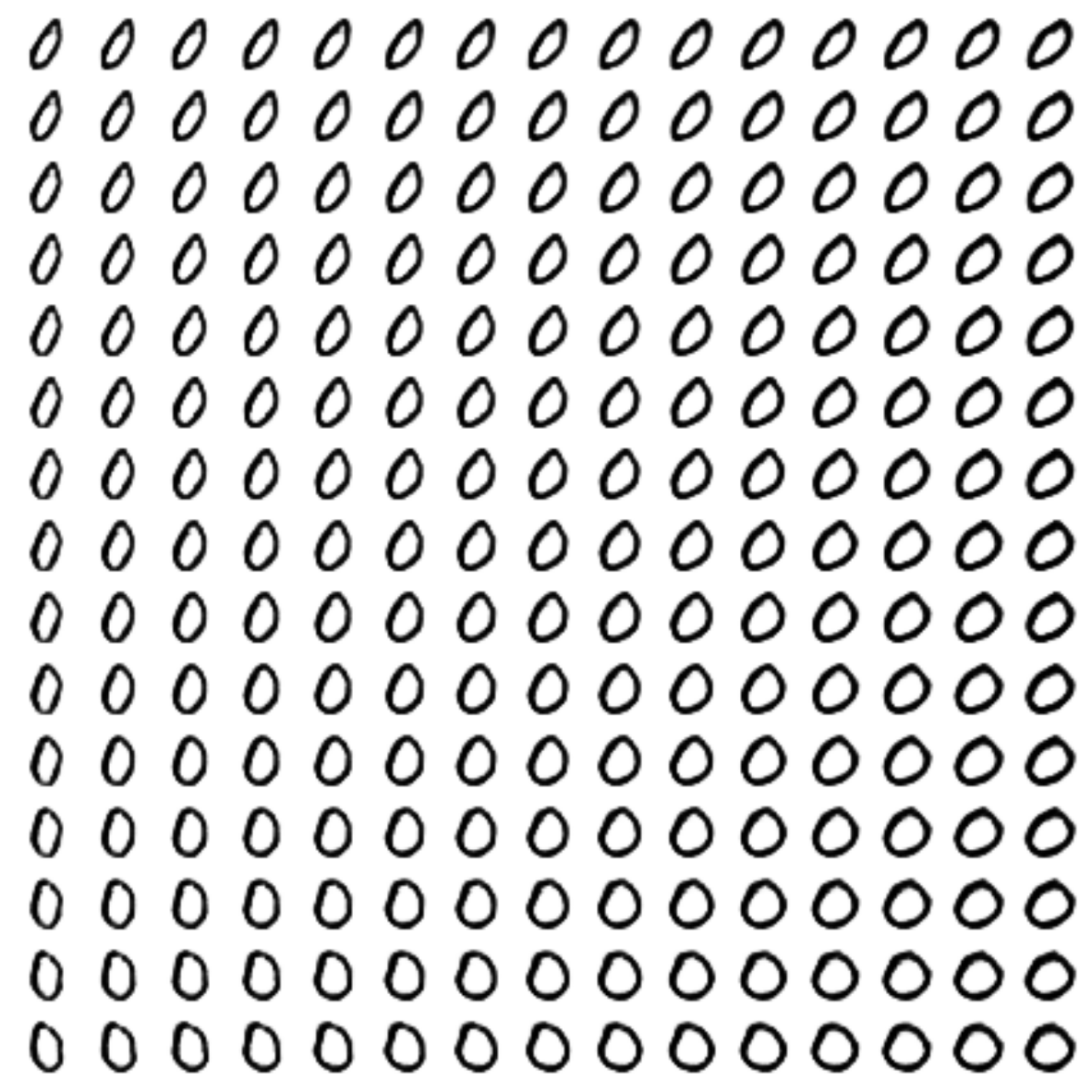
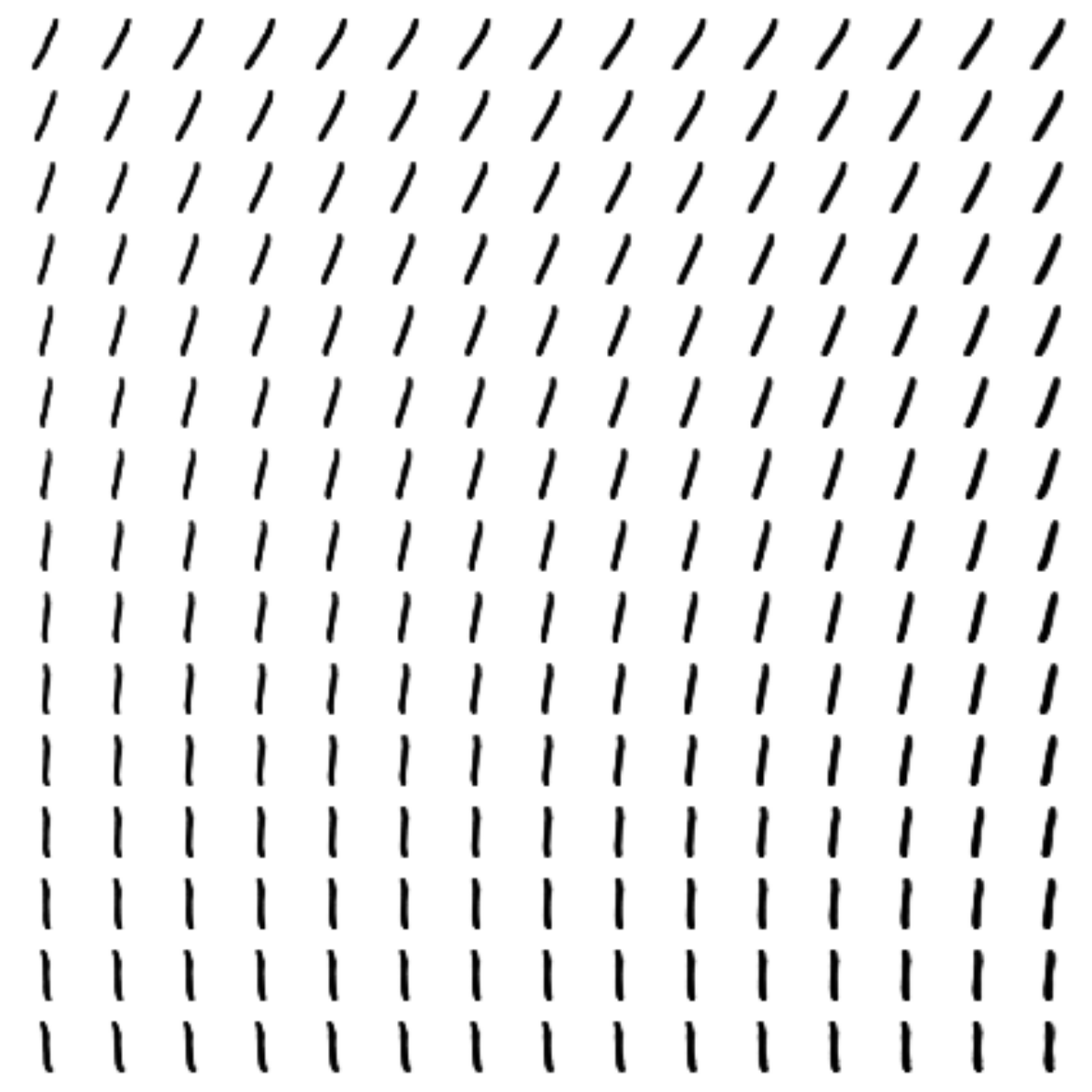

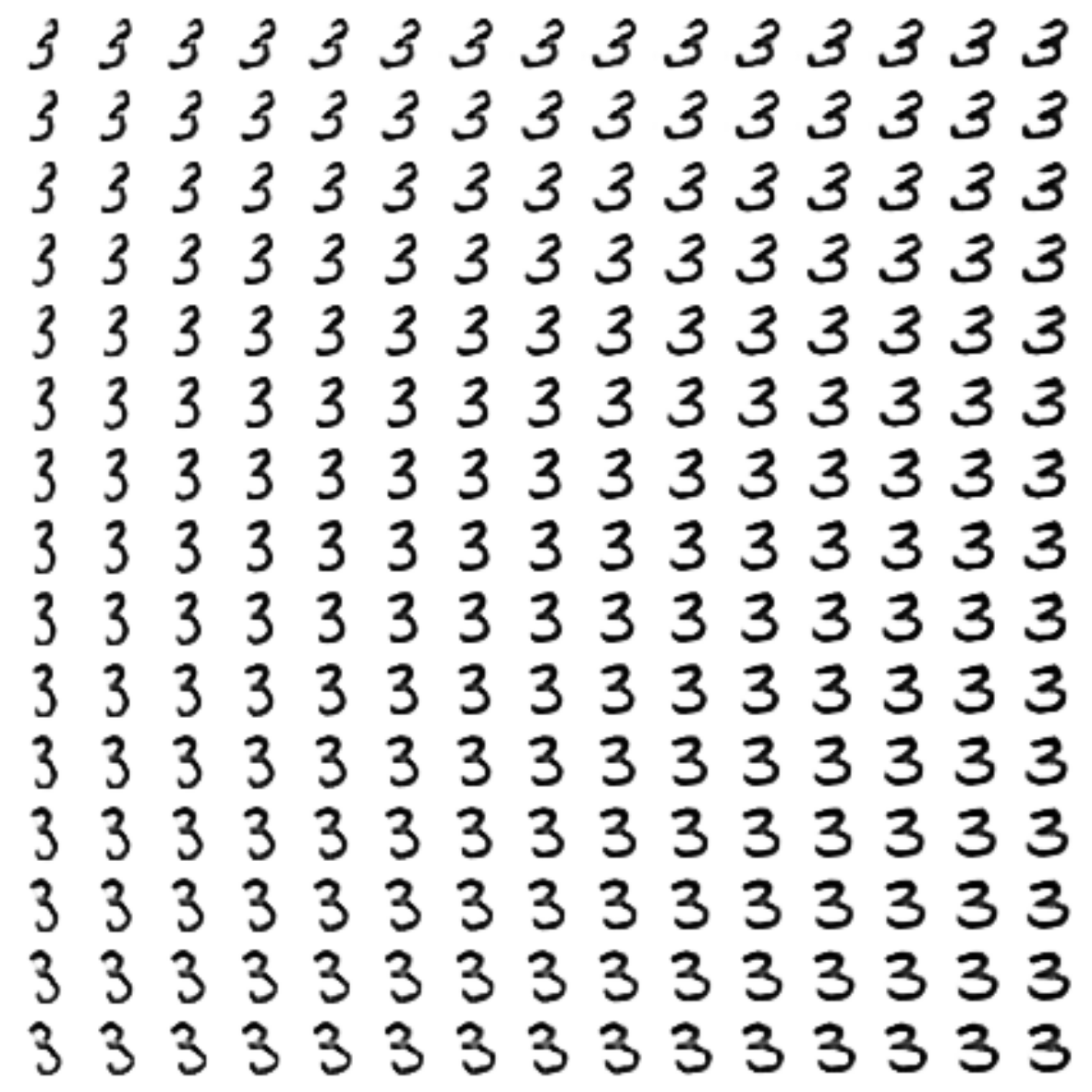
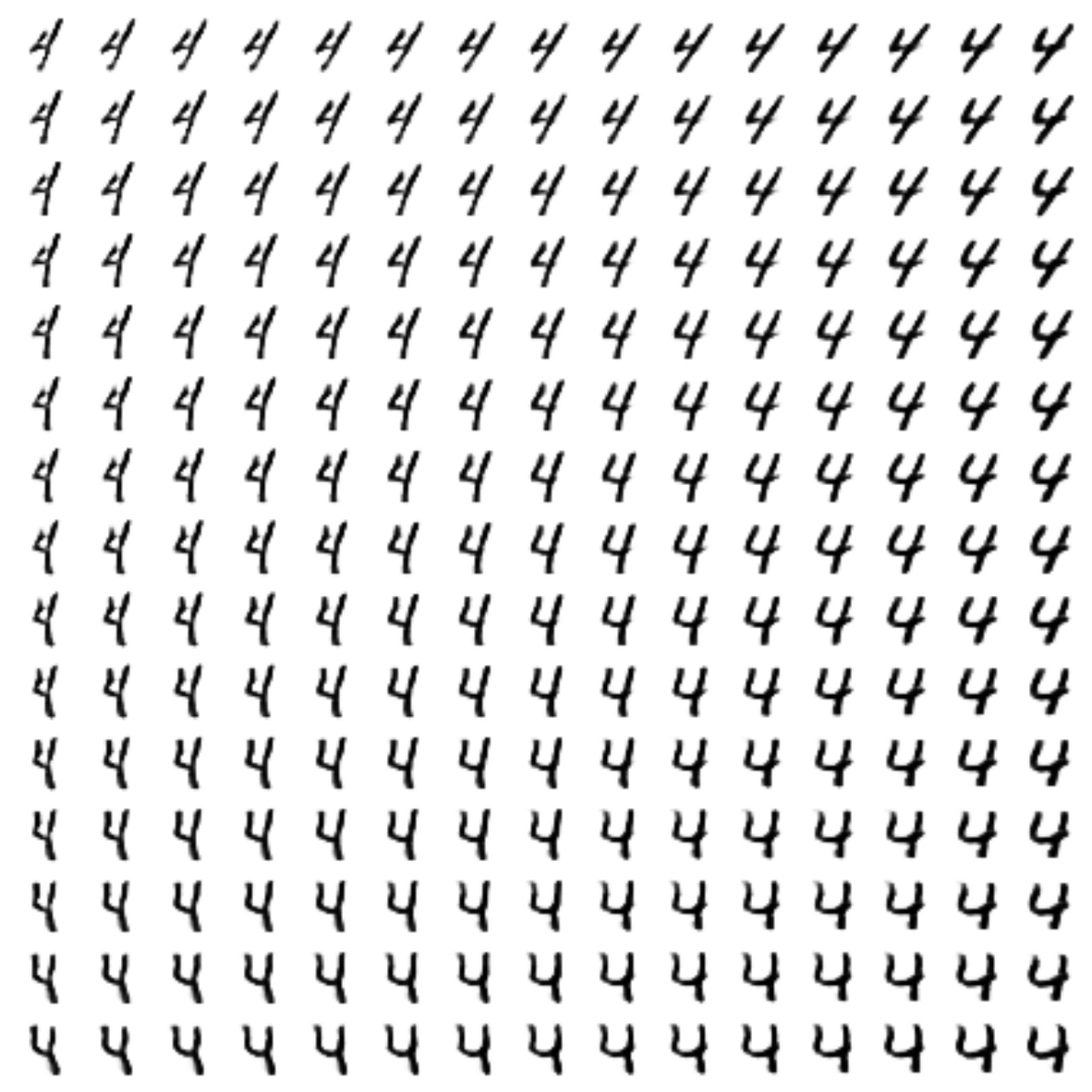
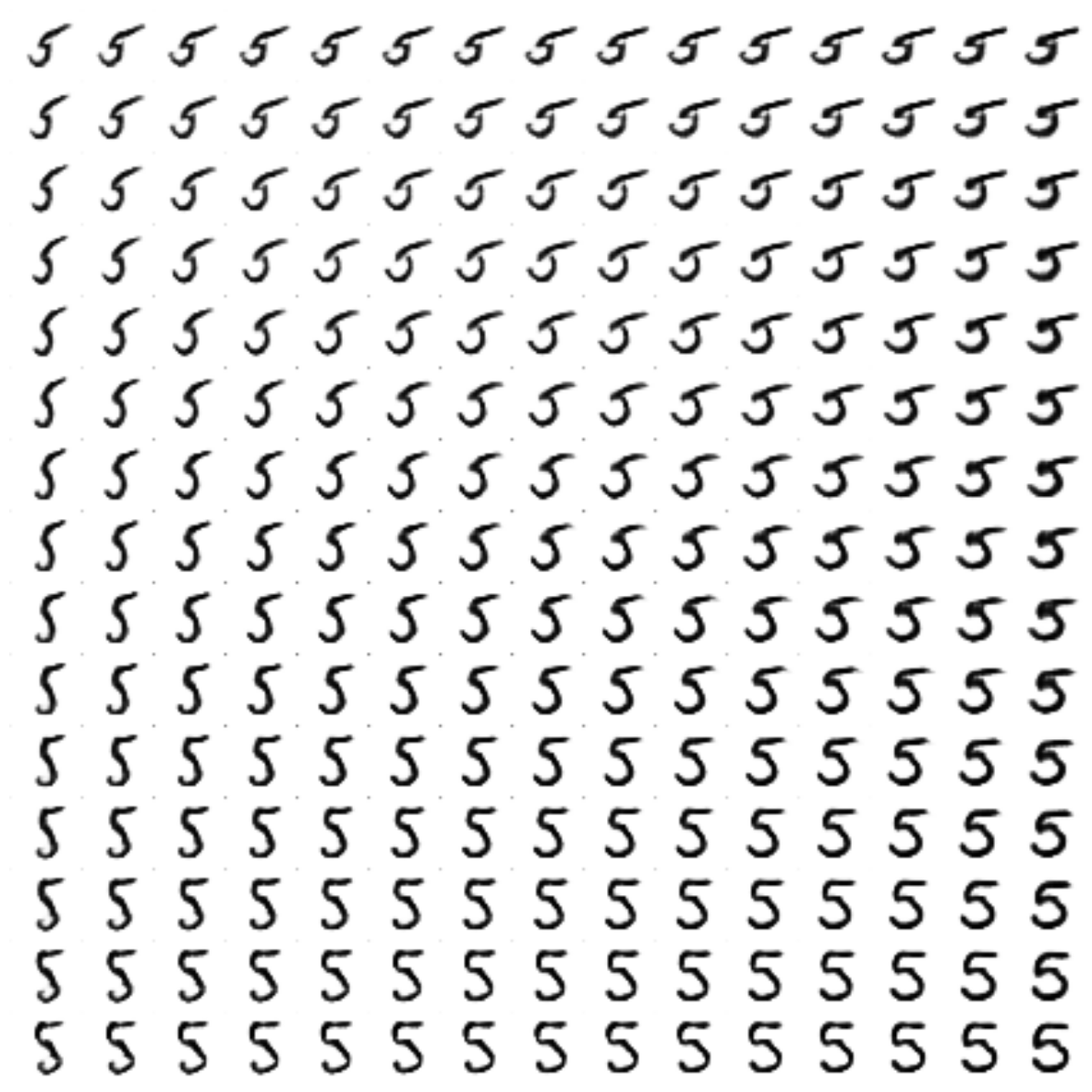
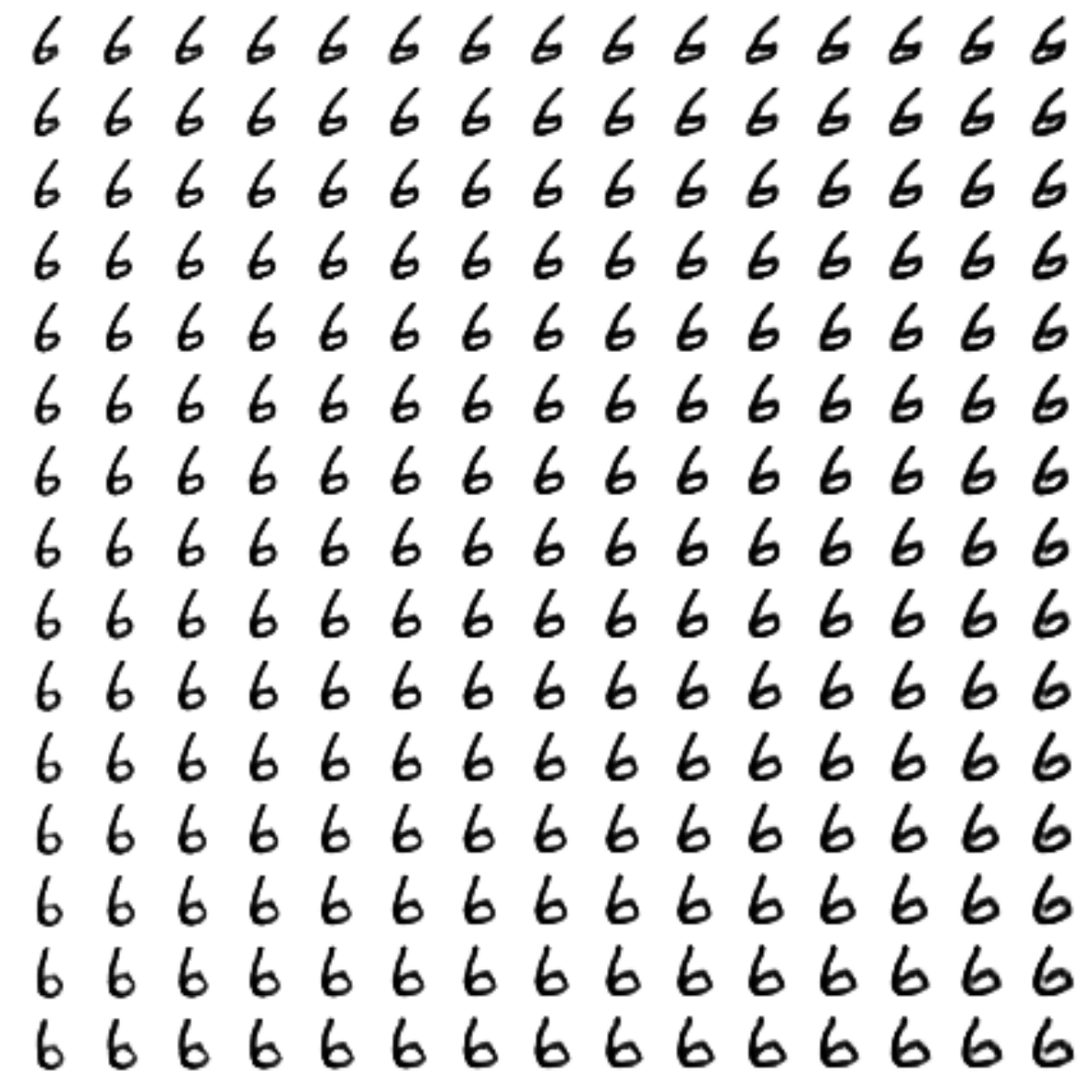
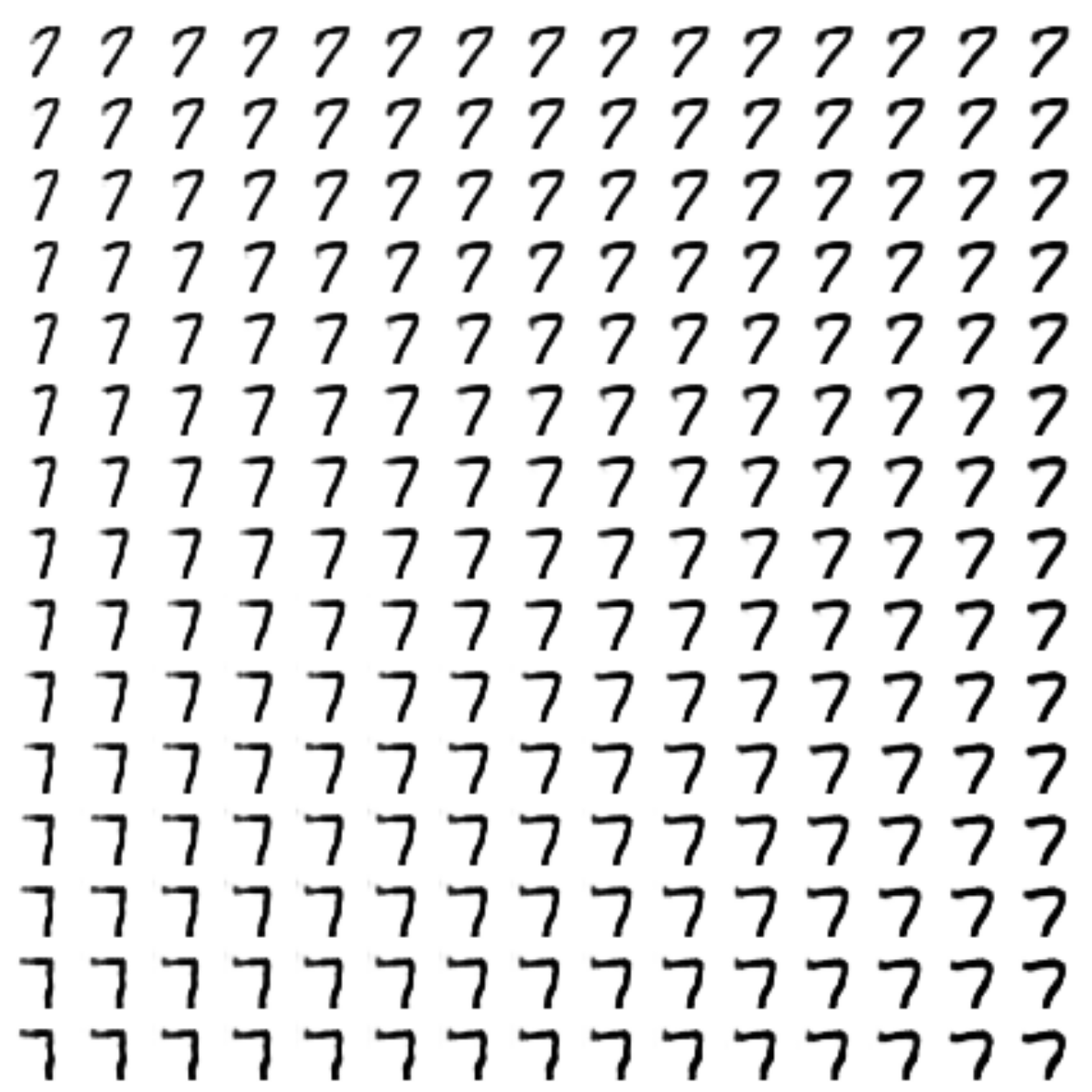
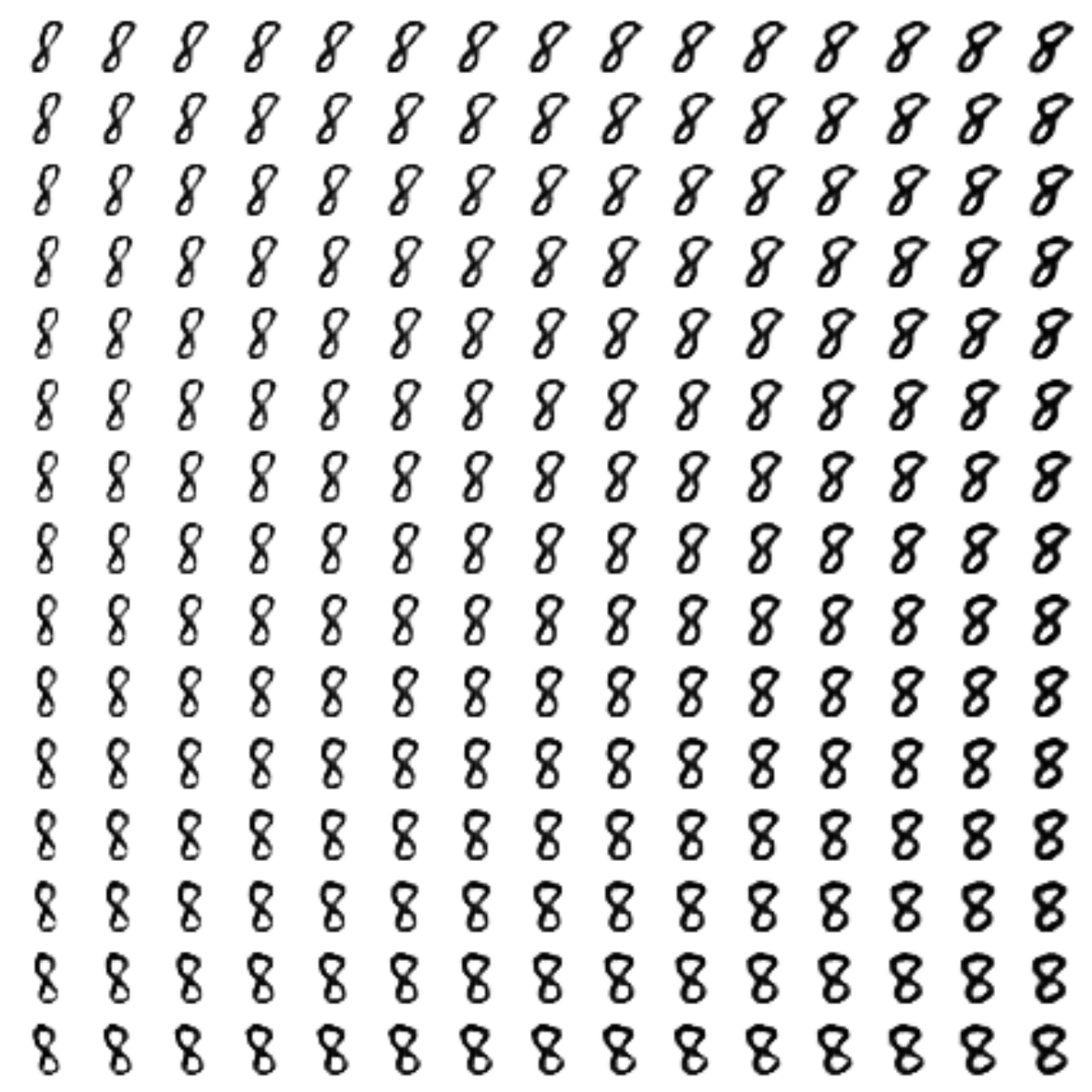
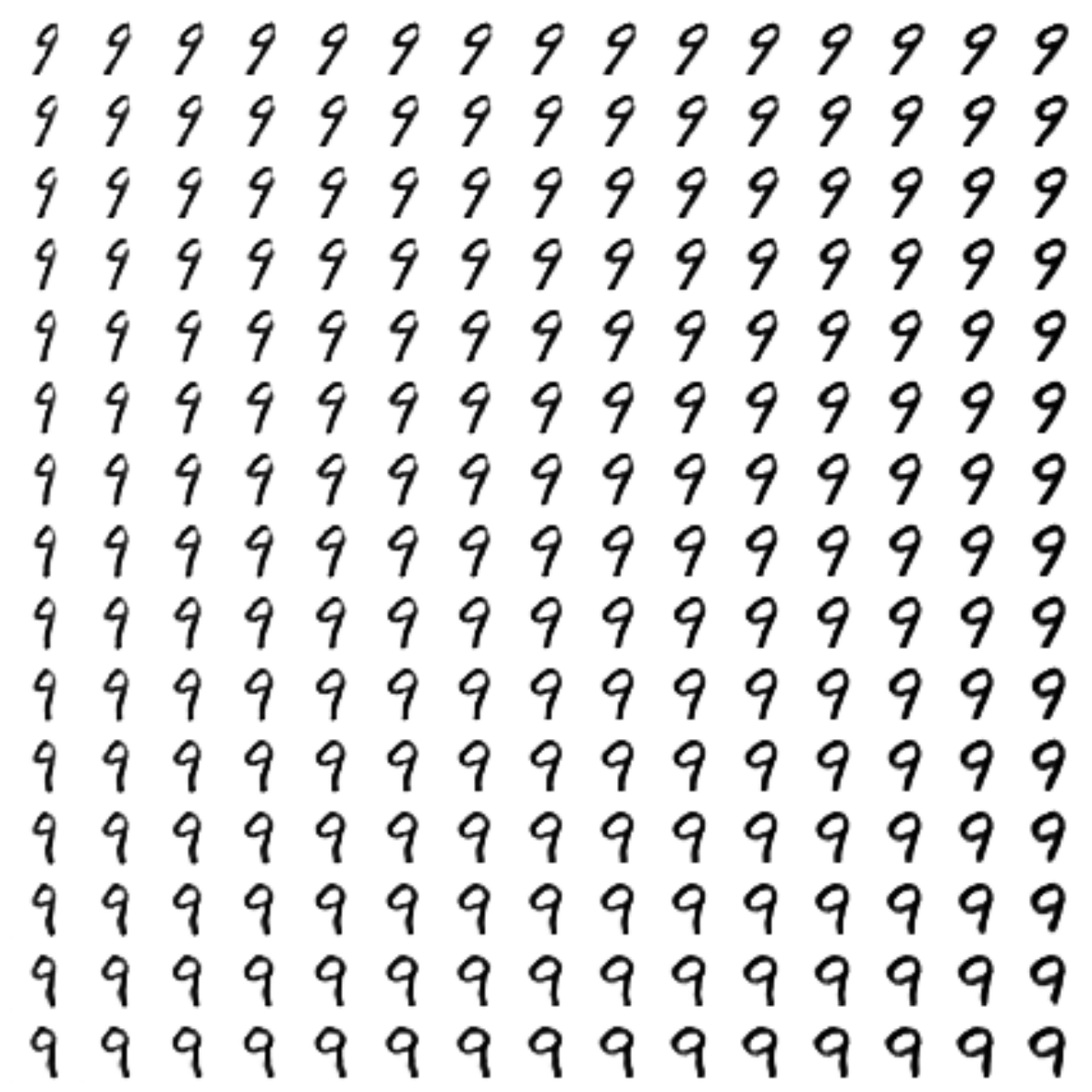
Learning process
Style transfer
The “7” was taken as a basis, from the style of which the rest of the figures were already created
So it was with a simple CVAE :
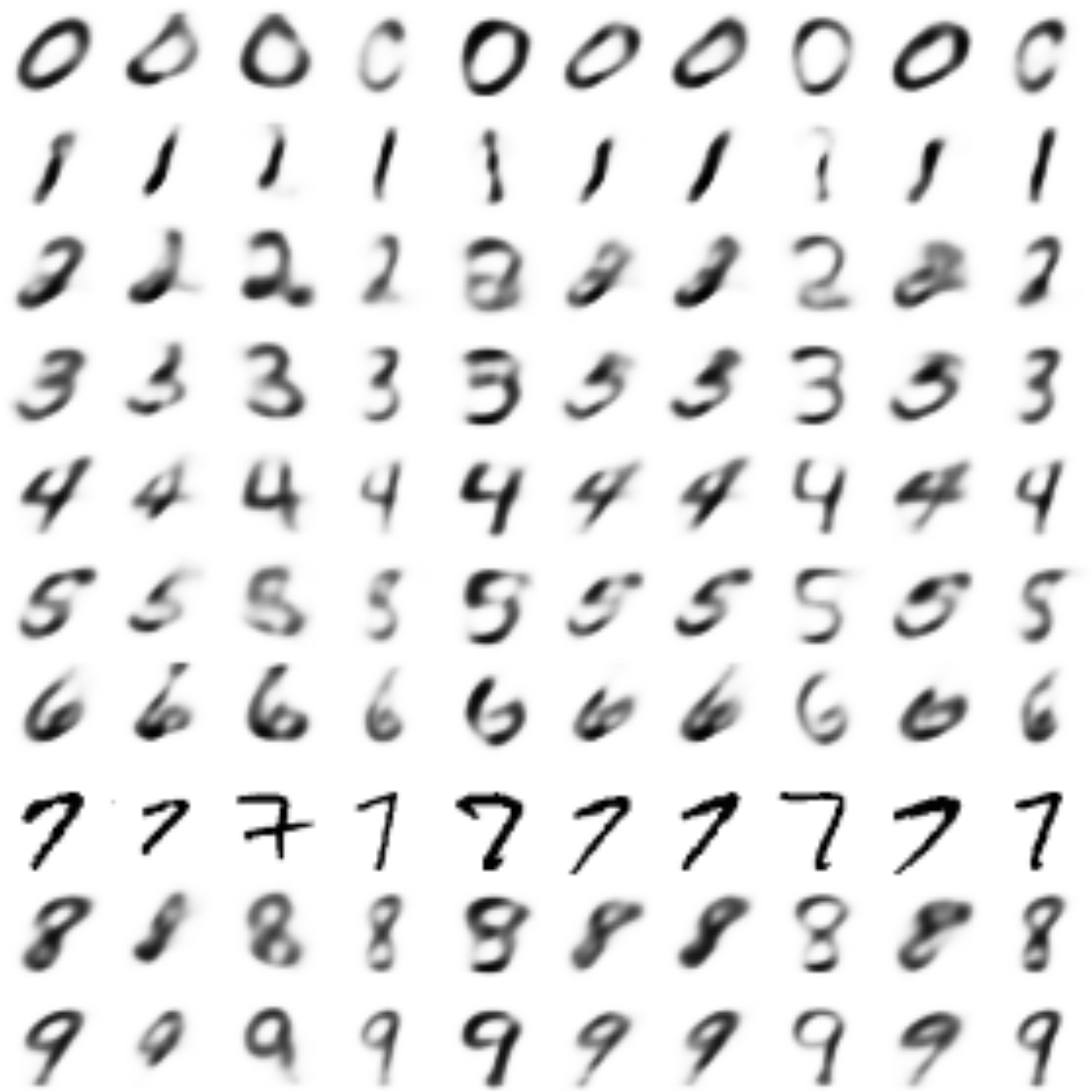
And so it became:
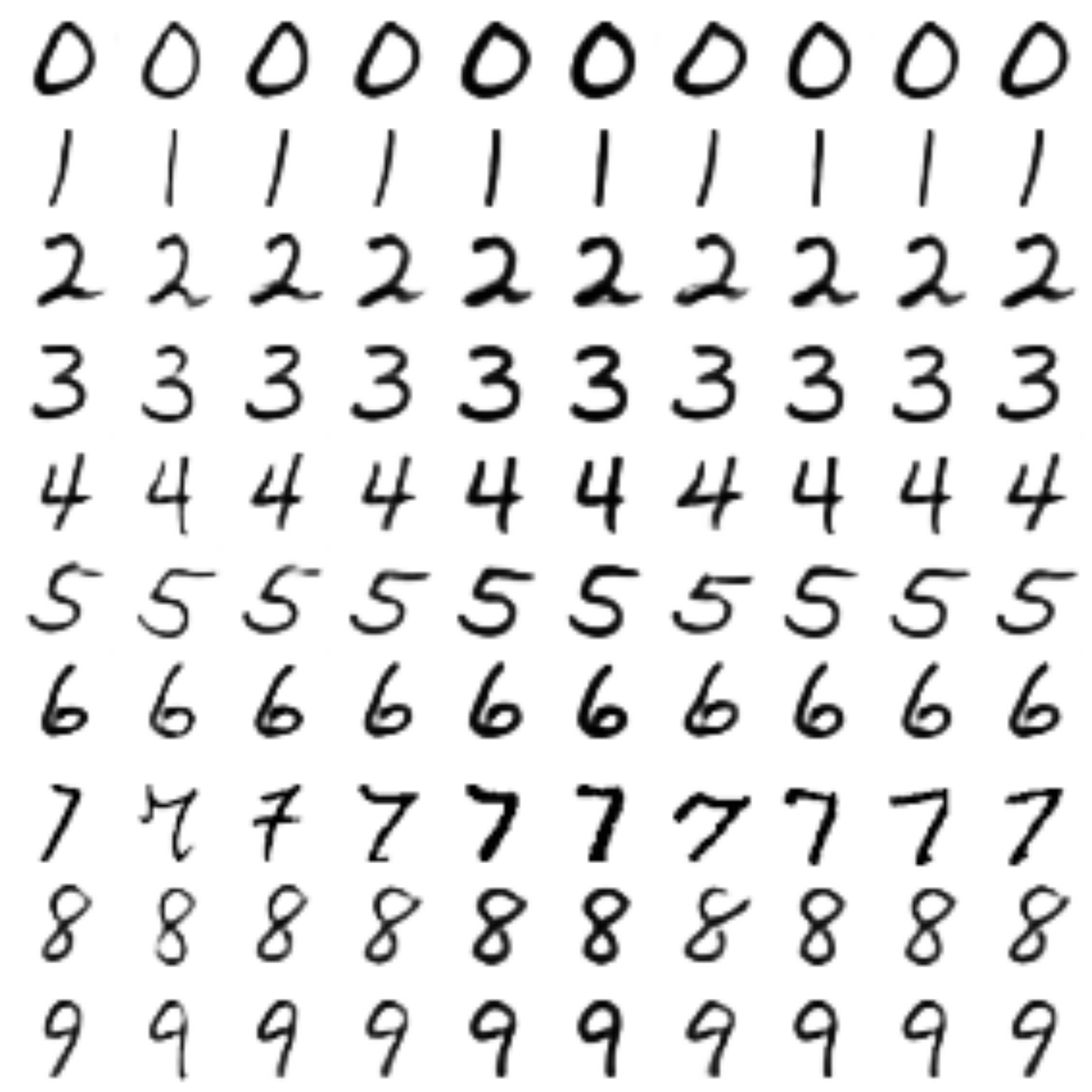
Conclusion
In my opinion, it turned out very well. Having gone from the simplest autoencoders , we reached generative models, namely, VAE , GAN , understood what conditional models are, and why the metric is important.
We also learned how to use keras and combine it with the bare tensorflow .
Thank you all for your attention, I hope it was interesting!
Repository with all laptops
Useful links and literature
Original article:
[1] Autoencoding beyond pixels using a learned similarity metric, Larsen et al, 2016, https://arxiv.org/abs/1512.09300
VAE Tutorial:
[2] Tutorial on Variational Autoencoders, Carl Doersch, 2016, https://arxiv.org/abs/1606.05908
Tutorial on using keras with tensorflow :
[3] https://blog.keras.io/keras-as-a-simplified-interface-to-tensorflow-tutorial.html
Source: https://habr.com/ru/post/332074/
All Articles

